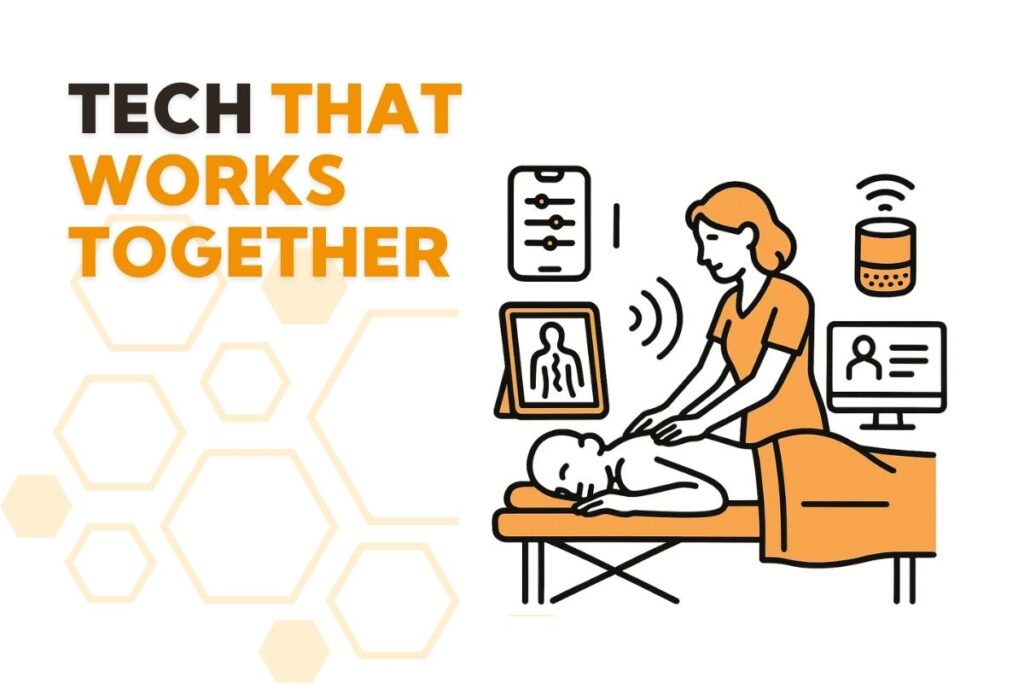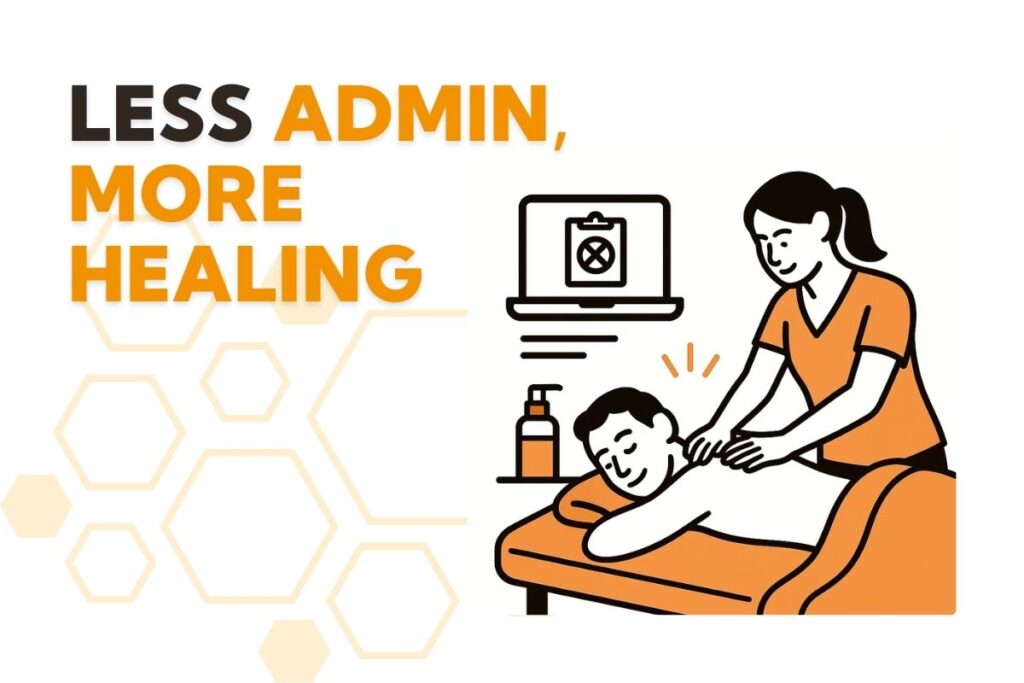Why integrating online booking with existing systems is the key to reducing errors and elevating client satisfaction in your massage clinic
Integrating online booking with existing systems is one of the most overlooked yet transformative upgrades a massage clinic can implement. As client expectations shift toward seamless, digital-first experiences, many clinic owners are stuck stitching together a mix of outdated tools—one for scheduling, another for SOAP notes, spreadsheets for payments, and manual text reminders on top. These disconnected systems don’t just slow you down—they create operational blind spots that lead to double bookings, communication breakdowns, missed appointments, and frustrated team members who spend more time troubleshooting than treating clients.
If this sounds familiar, you’re not alone. Many clinic owners find themselves bogged down in admin because their systems were never designed to work together. But the good news is: this is fixable. With the right integration strategy, you can eliminate redundancies, reclaim your time, and deliver a more professional, stress-free experience for both your team and your clients.
In this article, we’ll unpack the most common challenges of integrating online booking with existing systems, walk you through practical, step-by-step solutions, and show you how even small improvements can lead to big gains in efficiency, client retention, and clinic growth.
Why Disconnected Systems Hold You Back
A Patchwork of Tools Creates Hidden Friction
Most clinics adopt software reactively—adding booking tools, payment processors, or client notes one at a time. Without properly integrating online booking with existing systems, daily operations can feel more like a juggling act than a workflow.
- Scheduling apps that don’t sync with SOAP notes
- Manual reminders that slip through the cracks
- Staff wasting hours cross-referencing calendars and payments
Every workaround adds to your admin load, increases risk of error, and distracts from client care.
Manual Work Means More Mistakes
When systems aren’t integrated, simple tasks become prone to failure. You may experience:
- Clients double-booking or receiving the wrong reminder
- Notes missing from client files
- Payments that don’t reconcile with services provided
One Edmonton-based clinic lost over $3,000 in a single year due to issues caused by not fully integrating online booking with existing systems.
Team Burnout and Client Frustration
Therapists shouldn’t be tech troubleshooters. When systems are clunky or inconsistent, staff spend more time fixing problems than providing care. Clients notice—missed reminders, awkward rebookings, or inconsistent intake processes all chip away at trust.

Common Pain Points When Integrating Online Booking with Existing Systems
Data Silos That Disrupt Continuity
Without integration, each system holds different pieces of client data—notes in one place, bookings in another. This fragmented experience makes it hard to deliver truly personalized care or monitor client progress over time.
Compatibility Confusion
Not all systems play well together. Even platforms that promise to “integrate” often require third-party tools, developer support, or regular maintenance. For most clinics, this complexity becomes a barrier to adoption.
Staff Hesitation and Learning Curves
Rolling out new tools without proper training leads to low adoption rates. If your team isn’t comfortable with the platform—or if using it feels harder than the old way—it won’t stick.
Unplanned Expenses and Workflow Disruption
Some integrations come with hidden costs: feature add-ons, technical support, or downtime during migration. Without planning, what should be a helpful change can cause serious disruption.
How to Successfully Integrate Online Booking with Existing Systems
Step 1: Map Out Your Current Systems
Before integrating online booking with existing systems, take stock of your current setup. Identify:
- Tools used for scheduling, notes, payments, reminders
- Where inefficiencies or disconnects occur
- What tasks are repeated manually every day
Get input from your team—they know where things break down.
Step 2: Define What You Actually Need
Not every clinic needs a full-suite platform. Focus on what matters most:
- Real-time calendar syncing
- Integration with SOAP note software
- Automated email or SMS reminders
- Secure payment processing
Refer to this client experience automation checklist for clarity.
Step 3: Choose Systems Built to Integrate
Prioritize booking systems that:
- Offer native integrations with your existing tools
- Are cloud-based and secure
- Are easy to use and update without IT support
The right tech doesn’t need custom coding—it just needs to work.
Step 4: Prepare for Data Migration
If you’re changing platforms, proper data handling is essential:
- Export and back up all client data
- Clean up old or duplicate entries
- Set aside a test period before full launch
Plan downtime or transition windows that minimize impact.
Step 5: Equip and Empower Your Team
Integrating online booking with existing systems only works if your team embraces it. Support them with:
- Short, role-specific training sessions
- Internal documentation or cheat sheets
- A go-to person for troubleshooting during the rollout
You can further simplify their workflow using Hivemanager’s task automation tools.

What Clinics Gain from Better Booking Integration
More Time and Fewer Errors
Once integrated, your team won’t need to jump between systems or re-enter information. This saves time daily and eliminates unnecessary mistakes.
Higher Client Satisfaction
From first booking to follow-up emails, clients experience smoother communication. Their confidence in your clinic grows, along with their loyalty.
Improved Staff Retention
Integrated systems reduce mental load and free up therapists to focus on what they do best. That leads to better morale and lower turnover.
Growth-Ready Infrastructure
Whether you’re opening a second location or adding new services, an integrated booking system makes expansion easier. Everything is already in sync.
Building a Better Clinic, One Integration at a Time
Integrating online booking with existing systems doesn’t have to be overwhelming—even if you’re not tech-savvy. In fact, it’s one of the most strategic, cost-effective changes you can make to support your clinic’s long-term growth, reduce administrative stress, and enhance client satisfaction. The key is to start small and build momentum.
Focus on one high-impact area: syncing your booking system with your SOAP notes, automating appointment confirmations, or consolidating client data into one secure platform. These targeted upgrades eliminate repetitive tasks, reduce the risk of error, and free up your team to focus on what truly matters—client care.
Each step you take toward integration creates more consistency, fewer moving parts, and a more professional experience for your clients. And when your systems talk to each other, your entire clinic runs smoother—with less effort, fewer mistakes, and more time back in your day. Integration isn’t just about technology—it’s about building a business that can thrive without burning you out.
Frequently Asked Questions
You may need to consider switching to a more flexible platform. Look for one that supports API connections or offers native integrations with tools you already use.
Start with a pilot program using one or two users. Gather feedback, then roll out the system gradually with clear, role-based training.
Yes. Many modern systems allow partial integration or modular features that let you keep your current tools while improving connectivity.
Time savings. Automation reduces manual tasks, streamlines communication, and improves the overall client experience—giving you more time to focus on care.


